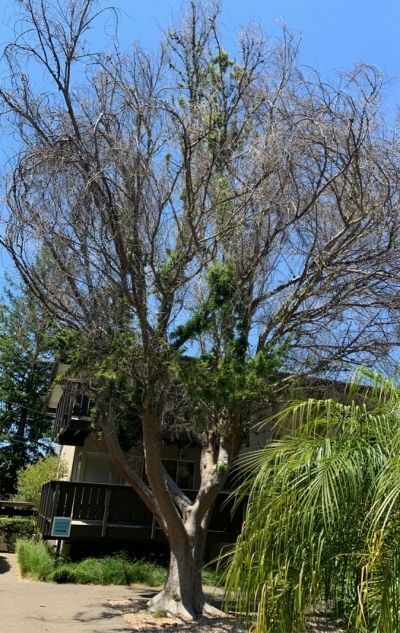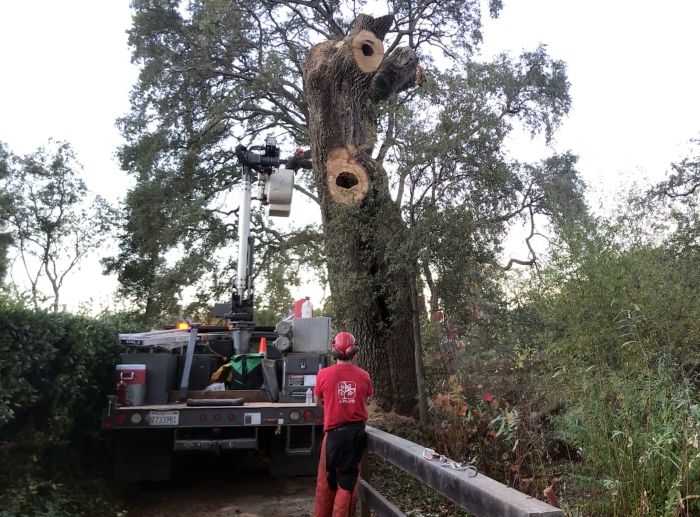Trees are remarkable living organisms, capable of withstanding various environmental stressors, diseases, and pests. But there comes a time when even the sturdiest tree may fall under these challenges. It can be difficult and confusing to distinguish between trees that are dead and those that are dormant, especially during the off seasons when deciduous trees naturally shed their leaves. Trees under severe stress may also shed their foliage and appear dead when they are actually still alive and capable of recovering.
If you’re ever unsure about your tree’s condition, consulting with a professional arborist is always the best course of action. However, there are several signs you can look for and some simple tests you can do yourself to determine if your tree is dying or has already passed and needs to be removed.
Symptoms Of A Dying Tree
A dying tree often shows several warning signs before it’s too late. These symptoms can include:
– Leaf Issues: Unseasonal yellowing or browning, undersized leaves, or a lack of leaves altogether.
– Branch Problems: Dead or dying branches, especially at the top of the tree.
– Bark Peeling: Significant loss of bark or the appearance of vertical cracks.
– Fungal Growth: The presence of fungal growth, such as mushrooms, at the base of the tree or on its trunk and branches.
– Wilted Leaves and Canopy: Overall, the tree looks wilted or droopy, indicating unhealthy growth.

How To Identify A Dead Tree?
A dead tree, unlike a dormant one, will show no signs of life when inspected closely. There will be no green tissue under the bark, branches will be brittle and snap easily, and there will be no budding or leafing out during the growing season. On top of that, the tree will often become a host to various fungi and pests because the tree’s natural defenses are no longer functioning.
Dead or Dormant?
The distinction between a dead tree and a dormant one can be subtle, but by inspecting it closely, you can learn a lot about a tree. Here’s how to identify between dead and dormant:

1# Look at The Buds
Even in dormancy, healthy trees will have buds that are waiting to burst open in spring. Check several branches for buds. If they are green inside and moist when you gently scratch them, the tree is likely alive but in a state of rest.
#2: The Snap-Snatch Test
One of the simplest methods to test a tree’s vitality is the snap-snatch test. Gently bend a small branch or twig. A living branch will bend and possibly snap but will be difficult to break completely and cleanly. Instead, branch fibers will cling together and it’ll show green, moist wood inside. Dead branches, on the other hand, will snap easily and cleanly, revealing dry, brittle wood.
#3: Check Out the Bark
Inspect the tree’s bark for signs of life. In many cases, a tree that’s alive will have a layer just beneath its bark that’s green and moist. You can check this by carefully removing a small section of bark from a few different areas of the tree. Dead trees will lack this green layer, showing dry, brown wood instead. Also, dead trees often have vertical cracks along the bark because the tree is no longer capable of growing and repairing bark fissures.
#4: Assess the Roots and Soil Beneath the Tree
Sometimes, the issue lies beneath the surface. Examine the soil around the tree and its visible roots for signs of rot, fungus, or pests. Healthy roots are firm and covered in bark, while unhealthy roots may be soft, decayed, or have a foul smell. Compacted soil or waterlogged conditions can also stress and potentially kill a tree by suffocating its roots.
#5: Inspect the Trunk
The trunk tells much of the tree’s story. Look for cracks, cavities, and significant bark loss. While some trees can live with these conditions for a while, they often indicate internal decay, which can lead to the tree’s eventual death. Also, check for sawdust-like material (aka frass) around the tree base, which could be a sign of boring insect activity.
How To Save A Dying Tree?
If you identify a tree as dying but not yet dead, you can sometimes save it by taking immediate action. Here are some ways to help revive your tree:
– Watering: Ensure the tree is getting enough but not too much water.
– Mulching: Apply wood chip mulch around the tree’s base to help retain moisture, regulate soil temperature, release nutrients, and suppress weeds.
– Pruning: Carefully prune away dead or dying branches, which can help redirect the tree’s energy to healthier areas.
– Soil Care: Address any soil issues, such as compaction or poor drainage, that may be affecting the tree.
– Consult an Arborist: For the best chance of saving the tree, consult with a professional arborist who can diagnose and treat specific issues.
When Does A Dead Tree Become Hazardous?
A dead tree becomes a hazard when its structural integrity is compromised, posing a risk of falling branches or the entire tree toppling over. This can threaten buildings, vehicles, and even lives. Signs that a dead tree has become hazardous include sudden and significant leaning, large dead branches, and hollow or decayed sections on the trunk or major limbs.

Why Should You Remove Dead Trees?
Removing dead trees is important for several reasons:
– Safety: Dead trees are unpredictable and can cause injury or property damage.
– Health of Surrounding Vegetation: Dead trees can harbor diseases and pests that may spread to healthy vegetation.
– Aesthetics and Property Value: Dead trees can be an eyesore, lowering property values and taking away from the beauty of your landscape.
– Liabilities: If a dead tree falls and causes damage, the tree owner may be held liable for repairs and damage costs.
While it’s sometimes possible to revive a dying tree, a dead tree is a risk that needs to be addressed promptly. If you need help assessing your trees or removing dead, hazardous trees, A Plus Tree is on hand to help! With a professional team of certified arborists, we can provide tree consultations and perform tree removals safely. Simply reach out for a free assessment!





